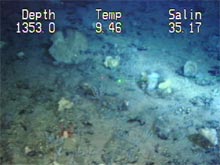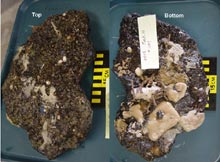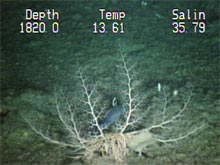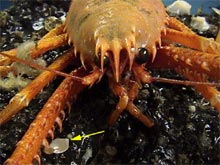
The sea bottom beneath the Gulf Stream is highly varied, and larvae, small as they are, must distinguish between suitable and unsuitable places to live. Click image for larger view.
Hanging On or Hiding Out: Life beneath the Gulf Stream
August 8, 2003
Steve Stancyk
Professor
University of South Carolina
Have you ever looked at the stars and thought about our insignificance in the universe? Similarly, as the Johnson-Sea-Link II submersible sank into the darkening water, I found myself thinking about the incredible vastness of the ocean, and our own insignificance in this tiny capsule. It’s not frightening, but it makes me marvel at the miraculous adaptations that allow organisms to survive in the strange and (to us) hostile environment of the deep sea. Imagine yourself as a tiny larva in over 1,400 ft of water, being swept along by strong currents like a butterfly in a hurricane. A few days, weeks or months ago (depending on your species), Mom sent you off on your own, maybe with a small lunch (if you came from a yolky egg), and now you have to find a place to live. If you are the kind of organism that permanently fastens itself to the substrate (e.g., coral, sponge, barnacle), you can’t just get up and leave once you settle and attach. Even if you are mobile, where you land influences your exposure to predators, physical forces and food. In any case, your choice of settlement site is crucial to your survival.

This rock is a good example of how tasty sponges, bryozoans and tunicates are absent from the exposed surface, but dominate the sheltered side. Click image for larger view.
The problem is that the environment is patchy, with rocks, mud, flat pavement and vertical surfaces all interspersed. For most organisms, not all of these habitats are good places to live, so how does a helpless little larva find a good home? Is it all up to chance? This is a difficult question to answer in the deep sea, where observations are rare and experiments are extremely difficult.
Nevertheless, observations and experiments with shallow-water organisms indicate that settling larvae can exert a lot of control over where they end up. For example, Dr. David Wethey has shown that in a flume of flowing water, both living and freshly killed barnacle larvae end up in the same place (in the sheltered spaces behind rough spots). Once there, however, the living larvae test several spots before finally attaching. As they get closer to metamorphosis (changing to adult form), many larvae move toward the bottom, and have been observed to “bounce” along the substrate until they find a good spot to attach. Another example is oyster larvae, which won’t attach to shells until they have been “aged” in seawater to give them the appropriate microbial coat. The larvae of some sand dollars won’t settle until they come in contact with adults of their species. All of these appear to be cases in which larvae are positioning themselves and using environmental cues to increase their chances of settling in a place where they can survive.

Passive filter feeders, such as this basket star, must find areas where strong currents sweep food through their arms. Click image for larger view.
Beneath the Gulf Stream, the same things appear to be occurring. Filter feeders that require high currents to sweep food past them (e.g., soft corals, basket stars, corals) dominate exposed outcrops, while filter feeders who can generate their own currents (e.g., sponges, sea squirts) are found in more sheltered habitats. Colonial sea squirts, bryozoans and sponges are among the favorite foods of grazing sea urchins, and appear to preferentially settle on the undersides of exposed rocks, where the urchins can’t get at them. Some larvae must be extremely specific in their choice, such as the little gooseneck barnacle we found attached to the carapace of a squat lobster. Others may be less choosy or have less control over where they settle. We found a beautiful blue encrusting sponge under the rocks, for instance. Others of its kind occur on the tops of dead stony corals, but not on living ones. I can imagine the little larva floating along near the bottom, waiting to be swept under a shelf, when it slams into an erect stony coral. If the coral is alive, the larva gets captured and turned into coral, but if the coral is dead -- "Hey, this is a pretty good spot to live: good current, above the urchins, and plenty of food."

This little gooseneck barnacle lives only on crab carapaces. What kind of cues do you think it uses to find such a specialized habitat? Click image for larger view.
The intricate and complex behavior that has evolved in larvae to enable them to find a good place to live is one of the things that fascinates marine biologists. As we drift along the bottom, I am struck once again by both the complexities and generalities that are revealed in all marine environments.
























